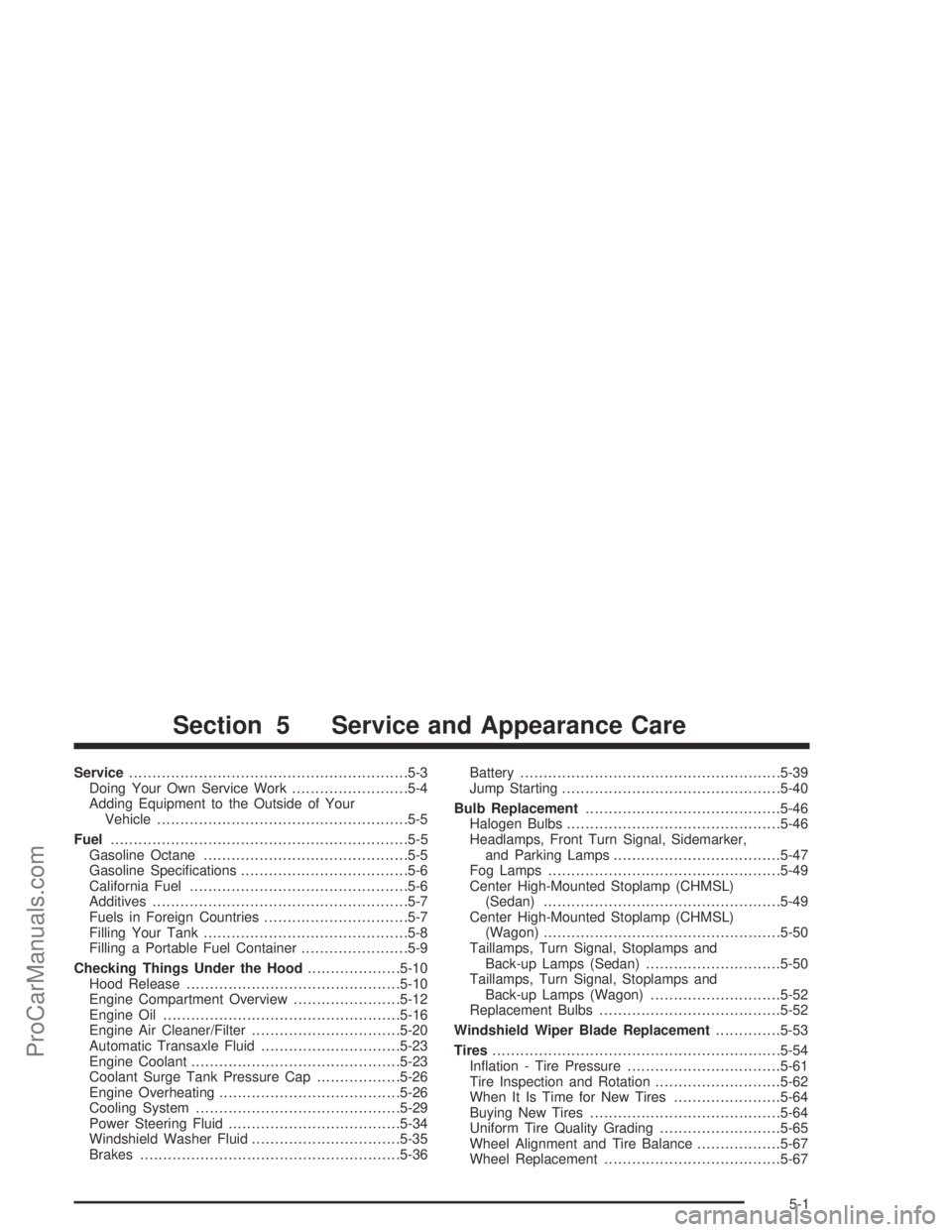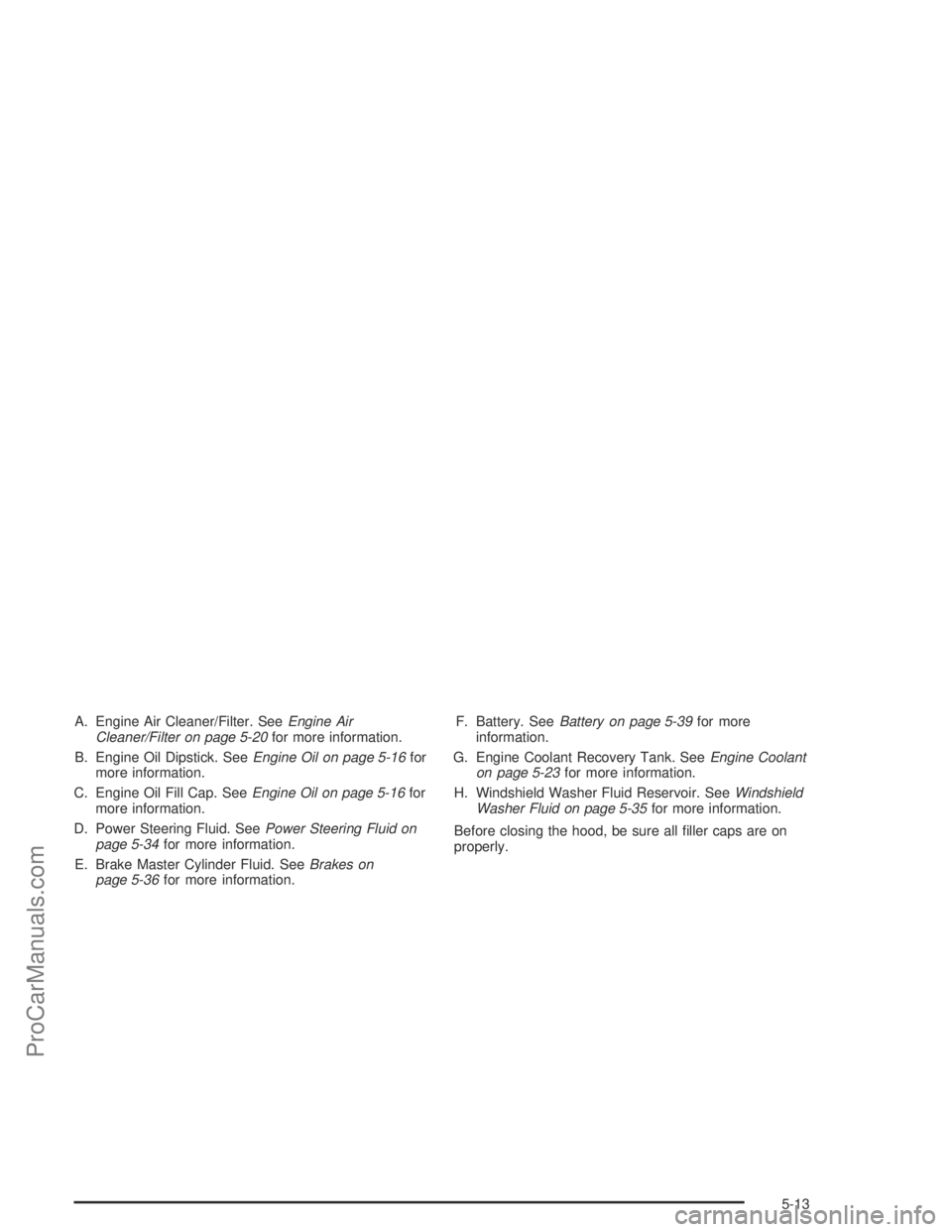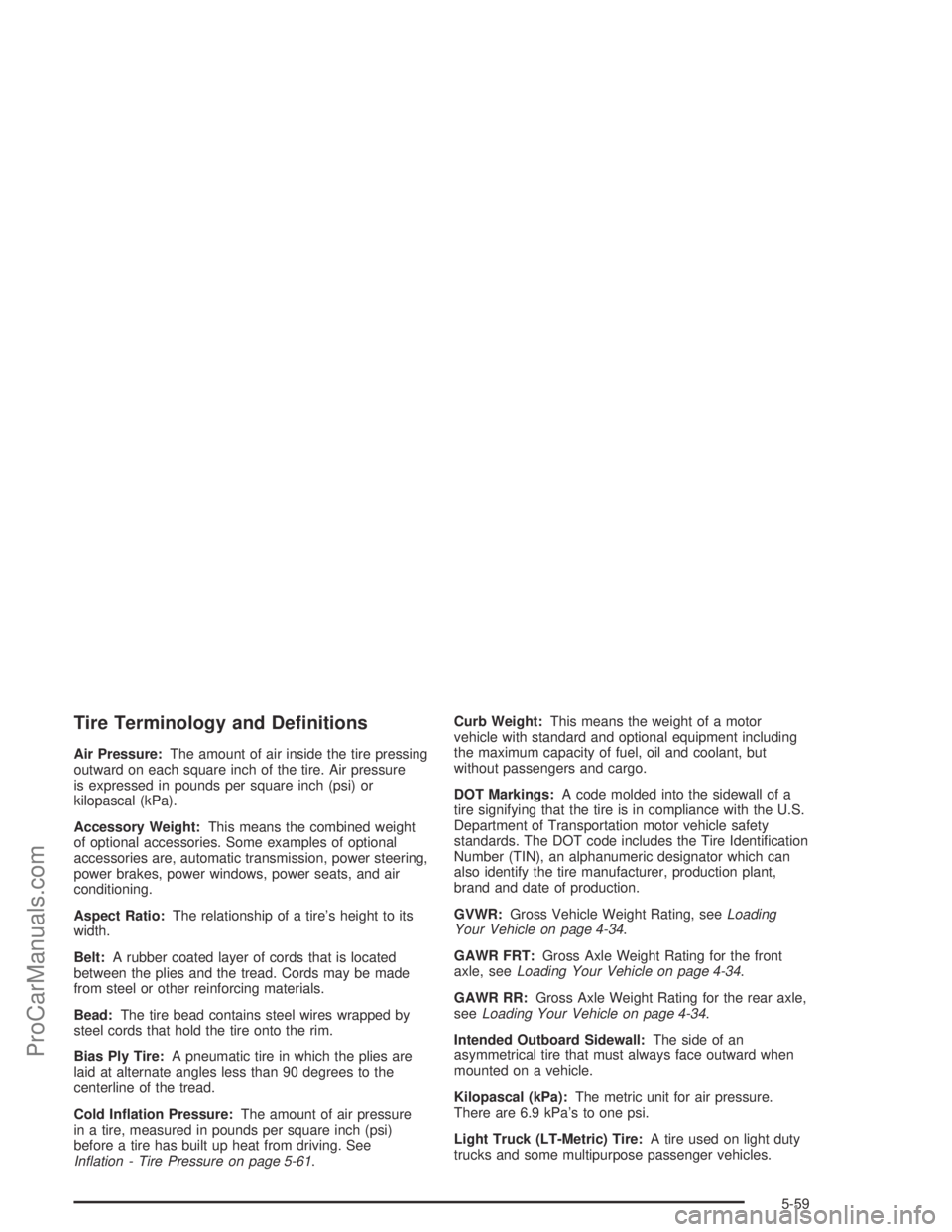steering SATURN L-SERIES 2004 Owner's Manual
[x] Cancel search | Manufacturer: SATURN, Model Year: 2004, Model line: L-SERIES, Model: SATURN L-SERIES 2004Pages: 386, PDF Size: 2.89 MB
Page 228 of 386

Remember, unless you have anti-lock, if you brake so
hard that your wheels stop rolling, you will just slide.
Brake so your wheels always keep rolling and you can
still steer.
Whatever your braking system, allow greater
following distance on any slippery road.
Watch for slippery spots. The road might be �ne
until you hit a spot that is covered with ice. On
an otherwise clear road, ice patches may appear in
shaded areas where the sun can not reach:
around clumps of trees, behind buildings or under
bridges. Sometimes the surface of a curve or
an overpass may remain icy when the surrounding
roads are clear. If you see a patch of ice ahead
of you, brake before you are on it. Try not to brake
while you are actually on the ice, and avoid
sudden steering maneuvers.
If You Are Caught in a Blizzard
If you are stopped by heavy snow, you could be in a
serious situation. You should probably stay with
your vehicle unless you know for sure that you are near
help and you can hike through the snow. Here are
some things to do to summon help and keep yourself
and your passengers safe:
Turn on your hazard �ashers.
Tie a red cloth to your vehicle to alert police that
you have been stopped by the snow.
4-28
ProCarManuals.com
Page 231 of 386

Rocking Your Vehicle To Get It Out
First, turn your steering wheel left and right. That will
clear the area around your front wheels. You should turn
your traction control system off. SeeTraction Control
System (TCS) on page 4-9. Then shift back and
forth between REVERSE (R) and a forward gear,
spinning the wheels as little as possible. Release the
accelerator pedal while you shift, and press lightly on the
accelerator pedal when the transaxle is in gear. By
slowly spinning your wheels in the forward and reverse
directions, you will cause a rocking motion that may
free your vehicle. If that does not get you out after a few
tries, you may need to be towed out. Or, you can use
your recovery hook. If you do need to be towed out, see
Towing Your Vehicle on page 4-32.
Using the Recovery Hook
Your vehicle is equipped with a recovery hook. The
recovery hook is provided at the rear of your vehicle. It
can only be used for pulling your vehicle out.
{CAUTION:
The recovery hook, when used, is under a lot
of force. Always pull the vehicle straight out.
Never pull on the hook at a sideways angle.
The hook could break off and you or others
could be injured from the chain or cable
snapping back.
Notice:Never use the recovery hook to tow the
vehicle. Your vehicle could be damaged and it would
not be covered by warranty.
4-31
ProCarManuals.com
Page 233 of 386

Dinghy Towing
You may dinghy tow your vehicle from the front following
these steps:
1. Set the parking brake.
2. Turn the ignition key to ACC to unlock the steering
wheel.
3. Shift your transaxle to NEUTRAL (N).
4. Open the lid on the underhood fuse block and
remove the IGN 0/3/CR and IGN 1/2 fuses.
Refer to the underside of the underhood fuse block
cover for speci�c fuse locations.
5. Close the lid on the underhood fuse block and store
the two fuses in a safe place.6. Close the hood.
7. Release the parking brake.
Once you have reached your destination replace the
IGN 0/3/CR and IGN 1/2 fuses.
Notice:If you exceed 65 mph (110 km/h) while
towing your vehicle, it could be damaged. Never
exceed 65 mph (110 km/h) while towing your vehicle.
Notice:Towing your vehicle from the rear could
damage it. Also, repairs would not be covered by the
warranty. Never have your vehicle towed from
the rear.
4-33
ProCarManuals.com
Page 234 of 386

Dolly Towing
Your vehicle can be towed using a dolly. To tow your
vehicle using a dolly, follow these steps:
1. Put the front wheels on a dolly.
2. Put the vehicle in PARK (P).
3. Set the parking brake and remove the key.
4. Clamp the steering wheel in a straight-ahead
position with a clamping device designed for towing.
5. Release the parking brake.
Loading Your Vehicle
It is very important to know how much weight your
vehicle can carry. This weight is called the vehicle
capacity weight and includes the weight of all occupants,
cargo and all nonfactory-installed options. Two labels
on your vehicle show how much weight it may properly
carry, the Tire and Loading Information label and the
Certi�cation label.
{CAUTION:
Do not load your vehicle any heavier than the
GVWR, or either the maximum front or rear
GAWR. If you do, parts on your vehicle can
break, and it can change the way your vehicle
handles. These could cause you to lose
control and crash. Also, overloading can
shorten the life of your vehicle.
4-34
ProCarManuals.com
Page 244 of 386

Driving with a Trailer
Towing a trailer requires a certain amount of experience.
Before setting out for the open road, you will want to
get to know your rig. Acquaint yourself with the feel of
handling and braking with the added weight of the trailer.
And always keep in mind that the vehicle you are
driving is now a good deal longer and not nearly as
responsive as your vehicle is by itself.
Before you start, check the trailer hitch and platform
(and attachments), safety chains, electrical connector,
lamps, tires and mirror adjustment. If the trailer has
electric brakes, start your vehicle and trailer moving and
then apply the trailer brake controller by hand to be
sure the brakes are working. This lets you check your
electrical connection at the same time.
During your trip, check occasionally to be sure that the
load is secure, and that the lamps and any trailer
brakes are still working.
Following Distance
Stay at least twice as far behind the vehicle ahead as
you would when driving your vehicle without a trailer.
This can help you avoid situations that require
heavy braking and sudden turns.
Passing
You’ll need more passing distance up ahead when
you’re towing a trailer. And, because you’re a good deal
longer, you’ll need to go much farther beyond the
passed vehicle before you can return to your lane.
Backing Up
Hold the bottom of the steering wheel with one hand.
Then, to move the trailer to the left, just move that hand
to the left. To move the trailer to the right, move your
hand to the right. Always back up slowly and, if possible,
have someone guide you.
Making Turns
Notice:Making very sharp turns while trailering
could cause the trailer to come in contact with the
vehicle. Your vehicle could be damaged. Avoid
making very sharp turns while trailering.
When you’re turning with a trailer, make wider turns
than normal. Do this so your trailer won’t strike
soft shoulders, curbs, road signs, trees or other objects.
Avoid jerky or sudden maneuvers. Signal well in
advance.
4-44
ProCarManuals.com
Page 247 of 386

Service............................................................5-3
Doing Your Own Service Work.........................5-4
Adding Equipment to the Outside of Your
Vehicle......................................................5-5
Fuel................................................................5-5
Gasoline Octane............................................5-5
Gasoline Speci�cations....................................5-6
California Fuel...............................................5-6
Additives.......................................................5-7
Fuels in Foreign Countries...............................5-7
Filling Your Tank............................................5-8
Filling a Portable Fuel Container.......................5-9
Checking Things Under the Hood....................5-10
Hood Release..............................................5-10
Engine Compartment Overview.......................5-12
Engine Oil...................................................5-16
Engine Air Cleaner/Filter................................5-20
Automatic Transaxle Fluid..............................5-23
Engine Coolant.............................................5-23
Coolant Surge Tank Pressure Cap..................5-26
Engine Overheating.......................................5-26
Cooling System............................................5-29
Power Steering Fluid.....................................5-34
Windshield Washer Fluid................................5-35
Brakes........................................................5-36Battery........................................................5-39
Jump Starting...............................................5-40
Bulb Replacement..........................................5-46
Halogen Bulbs..............................................5-46
Headlamps, Front Turn Signal, Sidemarker,
and Parking Lamps....................................5-47
Fog Lamps..................................................5-49
Center High-Mounted Stoplamp (CHMSL)
(Sedan)...................................................5-49
Center High-Mounted Stoplamp (CHMSL)
(Wagon)...................................................5-50
Taillamps, Turn Signal, Stoplamps and
Back-up Lamps (Sedan).............................5-50
Taillamps, Turn Signal, Stoplamps and
Back-up Lamps (Wagon)............................5-52
Replacement Bulbs.......................................5-52
Windshield Wiper Blade Replacement..............5-53
Tires..............................................................5-54
In�ation - Tire Pressure.................................5-61
Tire Inspection and Rotation...........................5-62
When It Is Time for New Tires.......................5-64
Buying New Tires.........................................5-64
Uniform Tire Quality Grading..........................5-65
Wheel Alignment and Tire Balance..................5-67
Wheel Replacement......................................5-67
Section 5 Service and Appearance Care
5-1
ProCarManuals.com
Page 259 of 386

A. Engine Air Cleaner/Filter. SeeEngine Air
Cleaner/Filter on page 5-20for more information.
B. Engine Oil Dipstick. SeeEngine Oil on page 5-16for
more information.
C. Engine Oil Fill Cap. SeeEngine Oil on page 5-16for
more information.
D. Power Steering Fluid. SeePower Steering Fluid on
page 5-34for more information.
E. Brake Master Cylinder Fluid. SeeBrakes on
page 5-36for more information.F. Battery. SeeBattery on page 5-39for more
information.
G. Engine Coolant Recovery Tank. SeeEngine Coolant
on page 5-23for more information.
H. Windshield Washer Fluid Reservoir. SeeWindshield
Washer Fluid on page 5-35for more information.
Before closing the hood, be sure all �ller caps are on
properly.
5-13
ProCarManuals.com
Page 261 of 386

A. Engine Air Cleaner/Filter. SeeEngine Air
Cleaner/Filter on page 5-20for more information.
B. Engine Oil Dipstick. SeeEngine Oil on page 5-16for
more information.
C. Engine Oil Fill Cap. SeeEngine Oil on page 5-16for
more information.
D. Brake Master Cylinder Fluid. SeeBrakes on
page 5-36for more information.
E. Power Steering Fluid. SeePower Steering Fluid on
page 5-34for more information.F. Battery. SeeBattery on page 5-39for more
information.
G. Engine Coolant Recovery Tank. SeeEngine Coolant
on page 5-23for more information.
H. Windshield Washer Fluid Reservoir. SeeWindshield
Washer Fluid on page 5-35for more information.
Before closing the hood, be sure all �ller caps are on
properly.
5-15
ProCarManuals.com
Page 280 of 386

Check the level in the surge tank when the cooling
system has cooled down. If the coolant is not at the
proper level, repeat Steps 1 through 3 and reinstall the
pressure cap. If the coolant isn’t at the proper level when
the system cools down again, see your retailer.
Power Steering Fluid
The power steering �uid reservoir is located toward the
front of the engine compartment on the driver’s side
of the vehicle. SeeEngine Compartment Overview on
page 5-12for more information on location.
When to Check Power Steering Fluid
It is not necessary to regularly check power steering �uid
unless you suspect there is a leak in the system or
you hear an unusual noise. A �uid loss in this system
could indicate a problem. Have the system inspected
and repaired. SeeEngine Compartment Overview
on page 5-12for reservoir location.
How to Check Power Steering Fluid
Turn the key off, let the engine compartment cool down,
wipe the cap and the top of the reservoir clean, then
unscrew the cap and wipe the dipstick with a clean rag.
Replace the cap and completely tighten it. Then remove
the cap again and look at the �uid level on the dipstick.
The level should be at the “C” mark. If necessary, add
only enough �uid to bring the level up to the mark.
What to Use
To determine what kind of �uid to use, see
Recommended Fluids and Lubricants on page 6-12.
Always use the proper �uid. Failure to use the proper
�uid can cause leaks and damage hoses and seals.
5-34
ProCarManuals.com
Page 305 of 386

Tire Terminology and De�nitions
Air Pressure:The amount of air inside the tire pressing
outward on each square inch of the tire. Air pressure
is expressed in pounds per square inch (psi) or
kilopascal (kPa).
Accessory Weight:This means the combined weight
of optional accessories. Some examples of optional
accessories are, automatic transmission, power steering,
power brakes, power windows, power seats, and air
conditioning.
Aspect Ratio:The relationship of a tire’s height to its
width.
Belt:A rubber coated layer of cords that is located
between the plies and the tread. Cords may be made
from steel or other reinforcing materials.
Bead:The tire bead contains steel wires wrapped by
steel cords that hold the tire onto the rim.
Bias Ply Tire:A pneumatic tire in which the plies are
laid at alternate angles less than 90 degrees to the
centerline of the tread.
Cold In�ation Pressure:The amount of air pressure
in a tire, measured in pounds per square inch (psi)
before a tire has built up heat from driving. See
In�ation - Tire Pressure on page 5-61.Curb Weight:This means the weight of a motor
vehicle with standard and optional equipment including
the maximum capacity of fuel, oil and coolant, but
without passengers and cargo.
DOT Markings:A code molded into the sidewall of a
tire signifying that the tire is in compliance with the U.S.
Department of Transportation motor vehicle safety
standards. The DOT code includes the Tire Identi�cation
Number (TIN), an alphanumeric designator which can
also identify the tire manufacturer, production plant,
brand and date of production.
GVWR:Gross Vehicle Weight Rating, seeLoading
Your Vehicle on page 4-34.
GAWR FRT:Gross Axle Weight Rating for the front
axle, seeLoading Your Vehicle on page 4-34.
GAWR RR:Gross Axle Weight Rating for the rear axle,
seeLoading Your Vehicle on page 4-34.
Intended Outboard Sidewall:The side of an
asymmetrical tire that must always face outward when
mounted on a vehicle.
Kilopascal (kPa):The metric unit for air pressure.
There are 6.9 kPa’s to one psi.
Light Truck (LT-Metric) Tire:A tire used on light duty
trucks and some multipurpose passenger vehicles.
5-59
ProCarManuals.com